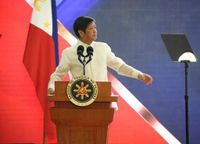Special Assistant to the President for Investment and Economic Affairs Secretary Frederick Go is set to travel to the United States to meet with the US Trade Representative (USTR) Jamieson Greer, following President Donald Trump's recent announcement of a 17% reciprocal tariff on Philippine goods. This development marks a significant moment in the ongoing trade relationship between the Philippines and the United States, as both nations navigate the complexities of international tariffs.
During a press briefing at Malacañang on Thursday, April 10, 2025, Go confirmed that the Philippine government had reached out to the USTR, expressing a desire to engage in discussions regarding the tariffs. “We have reached out to the United States Trade Representative, or USTR as it’s called. This office is responsible for all these trade tariffs,” Go stated. He emphasized the importance of this dialogue, noting that the USTR had responded positively to their request for a meeting.
Go explained that the upcoming trip would focus on negotiations rather than an appeal against the tariffs. “I think the keywords are probably not appeal, this is a negotiation,” he remarked. He expressed optimism that the best possible outcome of the discussions would be a free trade agreement between Washington and Manila. “A free trade agreement means zero tariffs on their side, zero tariffs on our side – that’s probably the best possible outcome of that meeting,” he added.
The context for these negotiations stems from President Trump's recent tariff announcement, which was made around April 3, 2025. The 17% tariff imposed on Philippine goods is notably lower than the 34% tariff that the Philippines currently applies to American imports. This disparity raises questions about the competitive landscape for both countries' exporters.
In comparison to its regional peers, the tariff on Philippine goods is relatively modest. For instance, Cambodia faces a staggering 49% tariff, Laos at 48%, Vietnam at 46%, Thailand at 47%, China at 34%, India at 27%, South Korea at 26%, and Malaysia at 24%. This context suggests that while the Philippines is facing new challenges, it is somewhat better positioned than some of its neighbors.
Go also highlighted the need for the Philippines to engage with its exporters to discuss potential measures and government assistance in light of these tariffs. “We have to engage with our exporters to discuss what are the possible measures that they can take and that the government can assist them in this current situation,” he noted. This proactive approach aims to mitigate the potential negative impacts of the tariffs on Philippine businesses.
In addition to engaging with exporters, Go emphasized the importance of monitoring the reactions of neighboring countries to the tariffs and how the United States is responding to their requests. “We have to monitor what our neighbors are doing, what their reactions are to the tariffs and how the US is reacting to their requests,” he stated. This vigilance will help the Philippines adapt its strategies in response to the evolving trade landscape.
Trade Secretary Maria Cristina Roque also weighed in on the situation, suggesting that the Philippines could leverage the relatively lower tariffs on its goods entering the United States compared to its regional counterparts. “The Philippines can take advantage of the relatively lower tariffs imposed on its goods entering America compared to its regional peers,” Roque remarked, hinting at potential opportunities for Philippine exporters.
The upcoming negotiations between the Philippines and the USTR are crucial not only for the economic relationship between the two nations but also for the broader regional trade dynamics. As countries in Southeast Asia grapple with the implications of US trade policies, the outcome of these discussions could have far-reaching effects.
As the Philippines prepares for this pivotal meeting, the focus will be on achieving a mutually beneficial agreement that could pave the way for enhanced trade relations and economic cooperation. The stakes are high, and the outcome of these negotiations will be closely watched by both domestic stakeholders and international observers.
In summary, Frederick Go's upcoming trip to the United States represents a critical step in addressing the challenges posed by the new tariffs. With a focus on negotiation and dialogue, the Philippines aims to foster a trade environment that supports its exporters while navigating the complexities of international trade.


